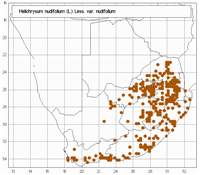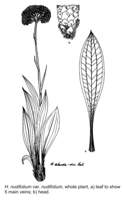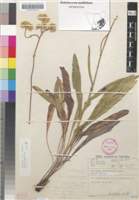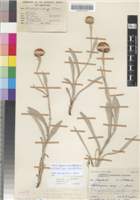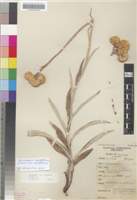Common names:
Cholocholo, Isidwabasokhovu, umgademthina. (Z); Hottentot's tea (E), Hottentottee (A), Mohlomela-tsie (SS), Umagada-emthini (Z)
Origin of name:
nudi = hairless folium = leaves
Diagnostic characters:
Bright green leaves with long petioleMedium sized headsCompact branched inflorescenceBright yellow / greenish yellow bracts
Description:
Perennial herb spreading by stout underground runners, roots narrowly fusiform, rootstock woody, crowned with old fibrous leaf bases with a little brown wool hidden in the axils, flowering stem solitary or several, erect, 100�450 (�750) mm tall, white-woolly-felted, leafy below, pedunculoid above with 1 or 2 much reduced leaves. Leaves thin to coriaceous, mostly radical, c. 60�200 x 13�33 mm, roughly half the length pseudopetiolar, (pseudo-) petiole 30�130 mm long, blade elliptic, tapering above and below, apex acute, apiculate, upper surface with minute soft pubescence, usually with some traces of wool as well or persistently thinly greyish silky-woolly, often with a skin-like layer of tomentum which flakes off to show a glabrous surface, lower surface greyish silky-woolly-felted, strongly 5�7-nerved, more or less reticulate as well, stem leaves similar but soon sessile, broad-based, clasping, shortly decurrent, reduced leaves and bracts lanceolate-acuminate. Heads homogamous, campanulate, c. 4�5 x 3�5 mm, many in a congested globose terminal cluster c. 15�30 mm in diam., or sometimes the compound inflorescence loose with clusters in a corymbose panicle. Involucral bracts in c. 4 series, outer 2 short, inner 2 subequal, equaling flowers, not radiating, all woolly on backs, tips translucent, crisped, obtuse, often erose, pale golden-brown or yellow. Receptacle with fimbrils exceeding ovaries. Flowers 18�45(�70). Achenes 1 mm long, cylindric, faintly ribbed, glabrous. Pappus bristles many, equaling corolla, scabrid, bases lightly fused.
Flowering between October and March.
Distribution:
Favours rocky grassland (especially regularly burnt short grassland) between (600-)1200-2000(-2750) m. Widely distributed from W. Africa, Angolan highlands to Yemen and Ethiopia, thence south through Kenya, Uganda, Tanzania, Malawi, Zimbabwe, Mozambique and the eastern half of S. Africa to the Cape Peninsula.
Savanna, Grassland, Thicket, Fynbos, Nama Karoo and Succulent Karoo Biomes.
Notes:
Very variable in leaf shape, width and indumentum, which shows no clear geographical partitioning. In the KwaZulu-Natal Drakensberg for instance, specimens with narrow glabrous leaves and wide-spreading inflorescences are common in grassland and stabilized boulder beds, while on moist rocky grass slopes, plants may have leaves white-tomentose below and the radical ones more distinctly petiolate than those of the glabrous-leaved plants and the inflorescence may be more contracted. These are possibly local ecological races: a thorough field study of the whole complex is needed, a formidable task.
Narrow-leaved specimens with only 3 main veins in the radical leaves are easily confused with H. miconiifolium, but can usually be distinguished by the stems being only distantly bracteate above. However, some specimens may be difficult to place, and it is not improbable that crossing takes place.
Closely allied to the widespread H. nudifolium var. pilosellum, but in that species the crown is conspicuously brown silky-woolly, the leaves are usually scarcely petiolate, harshly pubescent above with long coarse multicellular hairs, and mostly lack wool on the upper surface. Sometimes confused with H. coriaceum, which is immediately distinguished by its different leaves and straw-coloured involucral bracts.
The type of H. gerberifolium has leaves initially silky grey-woolly on both surfaces, later with only traces of wool; the type of H. davyi also has leaves persistently grey silky-woolly above, but plants with leaves scarcely woolly above seem just as common. The type of H. brunneum has only traces of wool clinging to the upper leaf surface.
Taxonomy:
Literature:
Helichrysum nudifolium (L.) Less., Syn. Comp. 299 (1832); DC., Prodr. 6: 200 (1838); Harv. in F.C. 3: 240 (1865); Levyns in Adamson & Salter, Fl. Cape Penins. 783 (1950); Adams in F.W.T.A. 2, 2: 264 (1963); Compton, Fl. Swaziland 632 (1976); Hilliard, Compositae in Natal 176 (1977).
Type:
Lectotype: Breynius, Cent. t. 71 (1674�1678).
Synonym(s):
Gnaphalium nudifolium L., Pl. Rar. Afr. 19 (1760), Sp. Pl. edn 2: 1196 (1763).Anaxeton nudifolium (L.) Gaertn., Fruct. 2: 407 (1791). Lepiscline nudifolia (L.) Cass., Dict. 26: 50 (1823). Euchloris nudifolia (L.) D. Don in Mem. Wern. nat. Hist. Soc. 5: 548 (1826). Helichrysum nudifolium var. scorzoneraefolium DC., Prodr. 6: 200 (1838).
G. plantagineum Burm. f., Prodr. 25 (1768), non L. (1767). Helichrysum nudifolium var. plantagineum DC., Prodr. 6: 200 (1838). Type: Specimen in herb. Burm. (G).
G. quinquenerve Thunb., Prodr. 152 (1800), Fl. Cap. 658 (1823). Helichrysum quinquenerve (Thunb.) Less., Syn. Comp. 300 (1832); Harv. in F.C. 3: 240 (1865); H. nudifolium var. quinquenerve (Thunb.) Moeser in Bot. Jb. 44: 265 (1910). Lectotype: Cape of Good Hope, Thunberg (sheet 19241, specimen on the right, UPS).
Helichrysum multinerve DC., Prodr. 6: 199 (1838), incl. vars. Gnaphalium multinerve(DC.) Sch. Bip. in Bot. Ztg 3: 172 (1845). Type: Eastern Cape, Van Staadens-riviersberg, Dr�ge 4996 (G-DC, holo.; var. pallens DC.).
H. nudifolium var. medium DC., Prodr. 6: 200 (1838). Lectotype: Eastern Cape, Camdeboo Berg, Dr�ge 852 (G-DC).
H. leiopodium DC., Prodr. 6: 200 (1838); Harv. in F.C. 3: 239 (1865). Gnaphalium leiopodium (DC.) Sch., Bip. in Bot. Ztg 3: 172 (1845). Helichrysum nudifolium var. leiopodium (DC.) Moeser in Bot. Jb. 44: 266 (1910); Compton, Fl. Swaziland 632 (1976); Hilliard, Compositae in Natal 178 (1977). Lectotype: Eastern Cape, between the Kei and Bashee Rivers, Dr�ge 5742 (G-DC).
H. nudifolium var. obovatum Harv. in F.C. 3: 240 (1865). Type: without precise locality, Ecklon s.n. (S).
H. leiopodium var. denudatum Harv. in F.C. 3: 239 (1865). Lectotype: Free State, Thaba Nchu, Zeyher 881 (K).
H. plantaginifolium C.H. Wr. in Kew Bull. 1901: 123 (1901); Moeser in Bot. Jb. 44: 267 (1910). Type: Malawi, Namasi, Cameron 6.
H. asperifolium Moeser in Bot. Jb. 48: 340 (1912). Type: Western Cape, Caledon div., Houw Hoek, 470 m, 30 iv 1896, Schlechter 7766 (BOL, iso.; Schlechter sub TM 1228, PRE, is possibly another isotype).
H. gerberifolium [Sch. Bip. ex] A. Rich., Tent. Fl. Abyss. 1: 425 (1848); Moeser in Bot. Jb. 44: 263 (1910).Type: Abyssinia [Ethiopia], near Adua, Scholada, 7 June 1837, Schimper 203 (P, holo.; G; K; S, iso.).
H. davyi S. Moore in J.. Bot., Lond. 43: 169 (1905); Compton, Fl. Swaziland 630 (1976). Type: Mpumalanga, Carolina distr., 1 mile N. of Robinson's, 10 Jan. 1905, Burtt Davy 2972 (BM, holo.; K; BOL and PRE under 2973, iso.).
H. brunneum Burtt Davy in Jl S. Afr. Bot. 1: 107 (1935). Type: Limpopo, Pietersburg distr., Shilouvane, Junod 1632 (K, holo.).
Vouchers:
Codd & De Winter 3223 (K; NU; PRE); Compton 27189 (NBG; PRE).